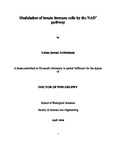Modulation of innate immune cells by the NAD+ pathway
| dc.contributor.supervisor | Billington, Richard | |
| dc.contributor.author | Al-Shabany, Abbas Jawad | |
| dc.contributor.other | School of Biological and Marine Sciences | en_US |
| dc.date.accessioned | 2017-01-24T11:47:36Z | |
| dc.date.available | 2017-01-24T11:47:36Z | |
| dc.date.issued | 2017 | |
| dc.date.issued | 2017 | |
| dc.identifier | 10258336 | en_US |
| dc.identifier.uri | http://hdl.handle.net/10026.1/8304 | |
| dc.description.abstract |
NAD+ has previously been shown to regulate TNF-α synthesis and TNF-α has been shown to regulate NAD+ homeostasis, thus providing a link between a pro-inflammatory response and redox status. Despite the well-established link between TNF-α and NAD+, the mechanism as to how NAD+ modulates TNF-α release is not fully understood. To achieve this, this link was investigated using THP-1 cell line-derived M1-like (pro-inflammatory) and M2-like (anti-inflammatory) macrophages using PMA and vitamin D3, respectively. NAD+ levels differed markedly between M1-like and M2-like macrophages, with M1-like having much higher basal levels. LPS increases NAD+ levels and TNF-α secretion in M1-like but not M2-like cells. In an effort to investigate the source of the NAD+ levels and the association with TNF-α release, three inhibitors (FK866, DPI and 1D-MT) were used. Following stimulation, NAD+ is produced partially via NADH oxidation and partially through NAD+ synthesis. Both DPI and FK866 reduced TNF-α secretion with DPI showing the largest effect. The two phenotypes showed differential profiles of NAD+ homeostasis gene expression compared with each other and with the progenitor THP-1 in both resting and activated states. While IDO expression was induced in both phenotypes, CD38 and NAMPT were upregulated in M1-like cells whereas CD157 was upregulated in M2-like cells. LPS induced M1-like cells to up-regulate CD38 and CD157 and down-regulate NAMPT unlike M2-like cells which up-regulated NAMPT and CD38 and down-regulated CD157. M1s increased glycolysis activity whereas conversely, decreased oxidative metabolism during LPS stimulation confirming previous findings showing that classical M1s are predominantly glycolytic. Collectively, these data suggest that the relationship between NAD+ levels and pro-/anti-inflammatory responses is complex and may be regulated via a combination of pathways. These findings open the possibility of pharmacological manipulation of NAD+ synthesis as a way of selectively modulating macrophage responses which may be beneficial for the development of therapeutics targeting inflammatory diseases. | en_US |
| dc.description.sponsorship | College of Science, Al-Qadisiyah University, Ministry of Higher Education | en_US |
| dc.language.iso | en | |
| dc.publisher | University of Plymouth | |
| dc.subject | Macrophages | |
| dc.subject | TNF-alpha | |
| dc.subject | Immune response | |
| dc.subject | NAD+ pathway | en_US |
| dc.subject.classification | PhD | en_US |
| dc.title | Modulation of innate immune cells by the NAD+ pathway | en_US |
| dc.type | Thesis | |
| plymouth.version | publishable | en_US |
| dc.identifier.doi | http://dx.doi.org/10.24382/545 | |
| dc.rights.embargoperiod | No embargo | en_US |
| dc.type.qualification | Doctorate | en_US |
| rioxxterms.funder | Not available | en_US |
| rioxxterms.identifier.project | Not available | en_US |
| rioxxterms.version | NA |
Files in this item
This item appears in the following Collection(s)
-
01 Research Theses Main Collection
Research Theses Main


